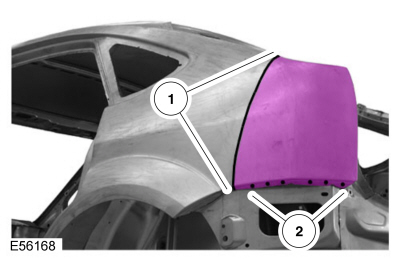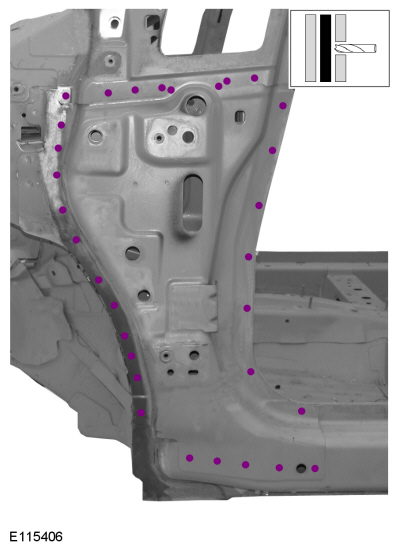Lincoln Navigator: Body Repairs - General Information / Complete Panel Replacement/Partial Replacement. Description and Operation
Partial Replacement

| Item | Description |
| 1 | Sectioning area |
| 2 | Manufacture weld joint |
Decision Criteria
The following points a crucial to the decision of complete or partial replacement of the part(s).
- Is the repair economically feasible.
- Retention/integrity of the original joint.
In
addition, sectioning or partial panel replacement must meet
standardized guidelines or approved procedures in the model specific
workshop manual for a sectional replacement solution in the damaged
area.
For additional information, refer to: Body Panel Sectioning
(501-26 Body Repairs - Vehicle Specific Information and Tolerance
Checks, General Procedures).
Depending on the damaged area, the following points need to be considered when determining whether to perform a partial repair or complete replacement:
- Sectioning cuts should be as short as possible.
-
Feature lines and panel margins must meet original manufacture design.
For additional information, refer to: Body and Frame (501-26 Body Repairs - Vehicle Specific Information and Tolerance Checks, Description and Operation).
.
- Inner reinforcement panels must not limit the straightening work.
- Inner reinforcement profiles in the pillar areas must allow for separation.
- Partial replacements on structural frame sections must be allowed for the specific vehicle being repaired. If no procedure exists, it must be assumed no sectioning is allowed.
- The large surface welding seams at the connections must be restored.
Advantages of Partial Replacement
A partial replacement repair offers many advantages for a professional repair of accident damage:
- Repairs can be made both in the outer panel area (e.g. side frame) and in the inner areas (e.g. structural member, trunk floor).
- The repair can be limited to the actual damaged area.
- Reduction of repair costs, as aggregates and other components can usually remain in the vehicle.
Complete Replacement
In a complete replacement, the original connections are largely reused.

A complete replacement is advantageous if the damaged body part can be detached from its original connections and the replacement part can be fitted without creating additional joints.
A complete replacement is necessary if there is no sectional replacement solution.
 Impact of Insufficient Repair Quality. Description and Operation
Impact of Insufficient Repair Quality. Description and Operation
Body
repairs usually require a significant level of intervention in the
existing body shell structure. The corrosion protection, seals and NVH components are destroyed and must be replaced...
Other information:
Lincoln Navigator 2018-2025 Workshop Manual: Air Inlet Door Actuator. Removal and Installation
Removal NOTE: Removal steps in this procedure may contain installation details. Remove the instrument panel. Refer to: Instrument Panel (501-12 Instrument Panel and Console, Removal and Installation). Disconnect the electrical connector, remove the retainers and the air inlet door actuator...
Lincoln Navigator 2018-2025 Workshop Manual: Factory Mode Deactivation. General Procedures
Deactivation NOTE: During vehicle build, some modules, such as the IPC and BCM are set in factory mode. Factory mode reduces the drain on the battery during longer periods where the vehicle is not used. While in the factory mode, various systems may be altered or disabled and the IPC displays FACTORY MODE CONTACT DEALER in the message center...
Categories
- Manuals Home
- 4th Gen Lincoln Navigator Service Manual (2018 - 2025)
- Brake Service Mode Activation and Deactivation. General Procedures
- Rear View Mirrors - System Operation and Component Description. Description and Operation
- Rear Bumper. Removal and Installation
- All Terrain Control Module (ATCM). Removal and Installation
- Front Bumper Cover. Removal and Installation
Rear Camber Adjustment. General Procedures
Special Tool(s) / General Equipment
Wheel Alignment SystemActivation
NOTICE: Suspension fasteners are critical parts that affect the performance of vital components and systems. Failure of these fasteners may result in major service expense. Use the same or equivalent parts if replacement is necessary. Do not use a replacement part of lesser quality or substitute design. Tighten fasteners as specified.
Using alignment equipment and the manufacturer's instructions, measure the rear camber.Use the General Equipment: Wheel Alignment System

